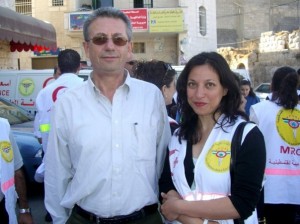University of Washington art exhibit focuses on war, peace and resilience
An art exhibit featuring photos about the Gaza war and blockade by award-winning Palestinian photojournalists, paintings from refugee children of different countries and Jewish & Palestinian artists, a photo-essay about medical relief and peace building efforts in Palestine, and a sculpture created by an Iraqi-American artist is now on display at the University of Washington’s Odegaard Undergraduate Library and can be seen through June 15.
The exhibit, “Global to Local: Narratives of War, Resilience and Peace,” is curated by Palestinian-American Seattle area artist and public health worker, Amineh Ayyad, a UW graduate. The show features four separate exhibits (to view exhibits, please click on titles below): “The Way I see It,” “Fragile and So Strong,” “Besieged,” and “Where Should We Go After the Last Frontiers?”
The art exhibit is timed to be on display during the 8th Annual Western Regional International Health Conference: War & Global Health which runs April 23-25 at the University of Washington in Seattle.

Amineh Ayyad, right, with Dr. Mustafa Barghouthi, during community solidarity work in the Palestinian village of Nilin. Barghouthi, president of the Palestinian Medical Relief Society and one of the most prominent leaders of the Palestinian struggle, has been nominated for the 2010 Nobel Peace Prize.
“I wanted to curate an art exhibit as a way to display qualitative and quantitative data about war, siege and displacement and their impact on health,” Ayyad says. “I believe this is an effective method to communicate such information to the university community, especially to the thousands of undergraduate students who visit the library daily.
“I choose diverse mediums deliberately, in an attempt to capture the visible and invisible narratives of people,” she says. “Photojournalism to show a portrait of daily life realities in Gaza through the lenses of Gazan photographers, encaustic paintings of refugee youth to tell narratives of war and its cross-generational effects, a photo-essay documenting the delivery of health services and peace building amidst conflict through the perspective of a health worker; and a stone sculpture of the mythological character, Icarus, to give meaning to an attempt to escape imprisonment and defy limitations.”
The images from “The Way I See It” are from award winning Palestinian photojournalists Khalil Hamra and Eman Mohammed. Hamra and Mohammed’s work document the events in Gaza during Operation Cast Lead, the 23-day attacks launched by the Israeli military in December 27, 2008 and the continuing Israeli blockade.
Ayyad included the original captions to weave a narrative of the realities of daily life in Gaza, the way Khalil and Eman see them, but she has had to make a number of changes to the captions to satisfy various people connected to the exhibit. While Khalil’s work depicts more of the ravaged Gaza, Eman’s work captures the resilience and determination of people to carry on with their lives amidst destruction in the aftermath of war and ongoing violence and siege.
The photo exhibit is accompanied by educational panels on Gaza, and the mental health effects of war and siege on civilians, but the exact language of those panels or whether they will even be included in the exhibit, is the subject of ongoing discussions with those in charge of the library.
“Fragile and So Strong” includes the work of refugee youth from Bhutan, Bosnia, Burma, Kenya, Somalia, and Ukraine. The purpose of this project is to empower refugee youth and to create peace and healing through health and art programs. Ayyad has been working with Jewish-American artist Janet Nechama Miller. Ayyad and Miller use unique mixed-media encaustic painting methods to capture the diverse narratives of the participants, as well as Ayyad and Miller’s own expressions.
In “Besieged,” Ayyad writes about the Palestinian Medical Relief Society’s (PMRS) teams in the Gaza Strip and the West Bank. The essay captures the bravery and camaraderie of a group of doctors, community health workers and volunteers who are determined to reach the most remote villages under siege. Ayyad says her essay shows PMRS’s commitment to peace and justice through empowering communities at the village level, and collaborating on medical relief & health research with diverse groups including the Israeli Physicians for Human Rights. In addition, she says her narrative sheds light on the psychological impact of war on these medical teams.
Ayyad is trying to raise money to bring Khalil to Seattle from April 24th to the 28th from New York where he will have just picked up the 2010 Robert Capa Gold Medal for his photography. To make a donation, contact Amineh Ayyad at amineh.ayyad@gmail.com.
Ayyad is a public health worker, filmmaker and artist whose work and research interests include international understanding and peacebuilding through health, and cultural and art exchange programs. She is currently working on Peace Through Health collaborative training curriculum for community health workers in Palestine and is the founder and director of Adapt International, a nonprofit organization that aims to design, deliver and evaluate community-based psychosocial interventions serving refugee youth through health and art programs locally and in the Middle East.
2 Comments to “University of Washington art exhibit focuses on war, peace and resilience”
-
Art exhibit focuses on war, peace and resilience | Looking for Trouble University Me — April 15, 2010 @ 4:07 am
-
Art exhibit focuses on war, peace and resilience | Looking for Trouble college university — April 15, 2010 @ 7:43 am
RSS feed for comments on this post. TrackBack URI